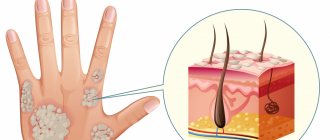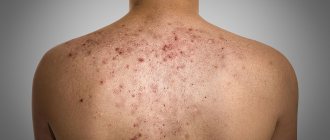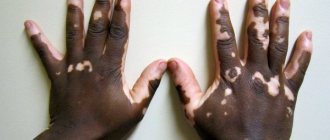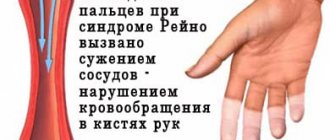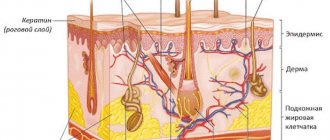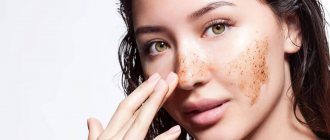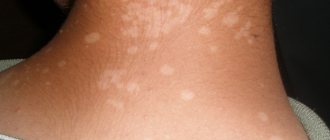Dry patches on the skin are quite common. They can appear at almost any age - both in infants and in adults and the elderly. There are a number of reasons that cause dry patches on the skin. However, not in all cases it is possible to find out the true cause of this disease. In any case, a medical examination is required to select effective treatment.
Dry spots, different in structure from normal skin, often occur in completely healthy people. Sometimes these phenomena are short-term in nature and go away on their own without requiring treatment. But there is a set of factors whose presence should alert you:
- the size of the spot gradually increases, its peripheral growth is observed;
- the stain does not disappear for quite a long time;
- after disappearing it may appear again;
- dry spots itch and itch and cause discomfort;
- ulcers, papules, and other rashes form;
- Similar symptoms appear in other family members.
Are you experiencing similar symptoms? See a doctor urgently! Sometimes skin problems signal the presence of serious diseases in the body.
Doctors name several reasons why dry patches may appear on the skin. Let's look at them briefly:
- Allergy. It is one of the most common causes of rashes due to contact with an allergen (cosmetics, medications, berries or fruits, etc.). Elimination of the allergen and appropriate therapy brings the situation back to normal.
- Fungus. It is often a provoking factor for the appearance of skin rashes and various spots. Requires serious and often persistent treatment.
- Stress. Psycho-emotional outbursts are often accompanied by skin problems.
- Changes in temperature and humidity. Seasonal dermatitis is a common and common occurrence. Frost, wind, and UF rays have a negative impact on the skin, leading to the appearance of dry spots and skin rashes.
- Dermatological diseases. The presence of dry patches is characteristic of some skin diseases.
- Diseases of the endocrine system and gastrointestinal tract. The skin reacts sharply to the presence of thyroid diseases and problems with the digestive system.
- Autoimmune diseases. Failure of the immune system leads to serious problems, including skin problems, including the development of necrotic processes.
Dry red patches on the skin
Almost all of us have encountered the phenomenon of dry red spots on the skin. They can occur when the body is exposed to irritating factors, in other words, allergens. It is allergens that in most cases provoke negative skin reactions, red rashes, often forming large areas of allergic damage. These rashes are characterized by itching and irritation.
Red spots that suddenly appear on the skin are characteristic symptoms of developing psoriasis. This disease is extremely difficult to treat. Consultation with a dermatologist is required. In some cases, stable remission can be achieved by following a special diet; long-term complex therapy under the supervision of a specialist is required.
Causes of the rash
If a small spot does not go away for several days or increases in size and turns red, you need to monitor the accompanying symptoms. Often, a stain indicates the appearance of pathogenic microbes in the body, that is, the development of a fungal infection. In addition, redness sometimes indicates an allergic reaction to food, medicines, pollen, animals or household chemicals. Endocrine and autoimmune diseases, as well as infectious damage to the body, are often accompanied by spots on the body.
Depending on the state of the immune system and the characteristics of the body, the symptoms of pathology can be pronounced or mild. You need to pay attention not only to changes in skin tone, but also to your well-being. Perhaps the spots will peel off, itch, swell, become covered with plaque or become wet. With rashes on the head, hair may fall out or break off, and yellow dandruff often appears. The itching can intensify to such an extent that a person's sleep at night is disturbed and chronic fatigue occurs.
Brown dry patches on the skin
With age, you can observe the appearance of brown dry spots on the skin. Changes in skin pigmentation and slight peeling may also appear during pregnancy. In both cases, the appearance of dark spots is not a pathology; these are natural processes that do not require treatment.
In the first case, the appearance of spots is associated with the aging process and the problem can be solved using special cosmetics, at home - masks with lemon. Brown dry spots on the skin of pregnant women can occur due to hormonal changes in the body. The problem is resolved without drug treatment, and after childbirth the pigmented spots disappear.
Pay special attention to new growths that appear that look like moles. Dangerous signs that require immediate treatment are the rapid growth of a mole, changes in its color and structure, the presence of uneven edges, pain, itching and bleeding. These signs are characteristic of cancer - melanoma.
Dermatological problems
The most common dermatological disease, characterized by the appearance of red spots - they are located locally or throughout the body - lichen. Experts distinguish several types of lichen, each of which has its own characteristics.
Red flat and ringing, scaly (psoriasis) and shingles, pityriasis and weeping (eczema) - all of them require the mandatory intervention of a specialist who can make a correct diagnosis and timely prescribe therapeutic measures. In addition, some types of lichen are transmitted by contact, which requires isolation of the patient from others, compliance with a special lifestyle, and exclusion of provoking factors.
Pathologies of the cardiovascular system and the consequences of frequent or constant stress and nervous tension.
The human body is a complex system in which everything is interconnected. Therefore, you shouldn’t be surprised if one of the consequences of nervous overstrain is redness of the skin (it’s not for nothing that people came up with the expression: “stains from nerves”). The reason for this phenomenon most often lies in vegetative-vascular dystonia, leading to impaired blood flow.
Redness of the skin will most likely not cause any pain and will go away on its own in a couple of days. However, you need to remember that quite serious diseases of internal organs can also lead to the appearance of spots: the cardiovascular system, gastrointestinal tract, etc. Therefore, any change in the skin should be a reason to contact a skin specialist.
Dry flaky patches on the skin
If you have dry, flaky patches on your skin, don’t rush into panic; perhaps this is how your skin reacts to a lack of moisture. To ensure that metabolic processes in the body proceed normally, do not forget to drink enough water. For an adult, the norm of fluid intake (all fluid entering the body is taken into account) is 1.5-2 liters. A healthy and balanced diet is the main condition for maintaining normal skin.
The problem of dry and flaky skin can be solved with the help of moisturizing cosmetics. Give preference to preparations with vitamin E. This vitamin perfectly combats dry skin and is recommended for the prevention of eczema. If the desired effect does not follow, consult a doctor. The appearance of dry, flaky patches may indicate a serious illness. A visual examination by a specialist, as well as laboratory diagnostics, will allow you to establish the exact cause for effective treatment.
Treatment of atopic dermatitis in children
In modern medicine, there are three degrees of severity of atopic dermatitis in children:
- Easy. The child responds well to treatment, remission can last more than 10 months, the itching is minor, the redness is slight. Exacerbations occur no more than twice a year.
- Medium-heavy. Exacerbations occur 3-4 times a year, and periods of remission are reduced to 2-3 months. The therapy gives less pronounced results, the redness “stubbornly” returns.
- Heavy. Long-term exacerbations are interrupted by short periods of remission - up to one and a half months. Treatment helps little or for a short period of time; the baby’s behavior is greatly affected by itching [4].
At all stages of atopic dermatitis, pediatricians and dermatologists recommend emollients - cosmetic skin care products. They moisturize the skin and help restore the level of lipids - the most important structural components. During periods of exacerbation, emollients can be applied frequently and generously.
Pay attention to the composition; it is advisable that emollients are not addictive. Their main tasks are to help the skin produce its own lipids, providing effective hydration and softening. In addition, the constant use of emollients prolongs periods of remission and alleviates the symptoms of atopic dermatitis.
The Mustela Stelatopia line of cosmetics will help restore skin comfort for a long time! Stelatopia emollients are effective at all stages of atopic dermatitis , incl. at its first signs - increased dryness of the skin.
Studies have confirmed that the use of Stelatopia emollient cream can reduce the likelihood of developing atopic dermatitis by 51% ! [6]
Treatment (use of hormonal drugs) for atopic dermatitis in children can only be prescribed by a doctor, taking into account age, symptoms, concomitant diseases and test results. Self-medication can be dangerous!
- For external therapy for moderate and severe degrees of atopic dermatitis, topical glucocorticosteroids, topical calcineurin inhibitors and others are used.
- In case of mild disease, the use of Stelatopia Emollient Cream reduces the severity of inflammation after 32 hours, due to the presence of sunflower oil in the distillate [5].
- In systemic therapy, the drugs dupilumab, cyclosporine, glucocorticosteroids and others are used orally or in injection forms.
- To relieve itching - clemastine, hifenadine, cetirizine, chloropyramine, levocetirizine and others. The use of Stelatopia emollient cream as a cosmetic skin care product reduces the severity of itching in 80% of cases [7].
- Physiotherapy treatment may include phototherapy. Sometimes, in the treatment of atopic dermatitis, diet therapy, acupuncture, plasmapheresis and some other methods may be prescribed.
How to deal with itchy skin
But what if a dry spot on the skin itches, but you can’t go to the doctor in the near future? In this case, you can alleviate the condition with the help of antihistamines, most of which are sold in pharmacies without a prescription. Try not to scratch the spots; it is better to lubricate the affected areas with anti-itch gel so as not to aggravate the situation. And, of course, do not neglect visiting a doctor. It is also necessary to review your diet and eliminate foods that provoke allergic reactions. In winter, it is necessary to ensure that the air in the room is not too dry. In summer, do not stay in direct sunlight for long periods of time.
Allergic reaction
The content of the article
Taking certain medications, as well as consuming a number of vitamins and foods, interacting with pets, getting bacteria or dust mites on the skin, inhaling pollen from flowering plants, etc., can trigger an allergic reaction. Most often, it manifests itself in the appearance of red spots scattered over the body and causing severe itching, which in particularly difficult cases can lead to Quincke's edema and even death.
In such a case, you will need to consult a dermatologist, who will identify the cause of the allergy and prescribe appropriate treatment. Eliminating provoking factors, using histamine blockers and local ointments will allow you to quickly forget about the problem and avoid complications.
White dry patches on the skin
Why do white dry spots appear on the skin? It is impossible to answer the question unequivocally. Among the reasons that provoke the appearance of such spots are the following:
- Prolonged exposure to the sun. Burnt skin peels off unevenly (popularly called “flaking”), resulting in the appearance of whitish areas on the skin. To normalize the condition, it will take some time - 1-2 weeks and the use of special cosmetics.
- Vitiligo. A disease associated with impaired pigmentation of the skin. At the same time, in some areas the skin looks as if it is discolored, in fact it is, since the coloring pigment melanin is completely absent there.
The onset of the disease can occur at any age. The hands, face, knees, and elbows are most often affected. The nature of the disease is not fully understood. With vitiligo, white spots cause only aesthetic discomfort. The disease is practically untreatable. Sometimes the spots disappear spontaneously. It is recommended to take antioxidants and immunomodulators. Be careful with sun exposure and contact with phenol derivatives.
- Pityriasis versicolor or versicolor. The appearance of whitish spots is characteristic of infection with pityriasis versicolor. A chronic disease that affects the stratum corneum of the epidermis. Drug treatment is required.
Causes of atopic dermatitis in children
Atopic dermatitis can be considered a hereditary disease, because the most important role in its occurrence is played by a genetic factor [3]:
- In 80% of children, it occurs if both parents have or have had atopic dermatitis.
- In more than 50% of children - if at least one of the parents was sick, especially the mother (this doubles the risk of transmitting the disease “by inheritance”).
Some prenatal factors can also provoke atopic dermatitis in a baby: for example, poor nutrition of the expectant mother, contact with toxic substances, infections suffered during pregnancy, as well as bad habits and stress.
In addition, atopic dermatitis more often develops in babies who suffered oxygen deprivation during childbirth, were born prematurely and were bottle-fed (perinatal factors).
Who to contact for skin diseases
If there are no serious reasons for concern, and you observe individual skin imperfections, consult a cosmetologist. If you have any symptoms characteristic of skin diseases - redness, rash, spots, you should consult a dermatologist. The specialist will quickly determine the cause of the disease and prescribe effective treatment.
If necessary, you will be referred for consultation to other specialists - an allergist, dermatovenerologist, endocrinologist or gastroenterologist. Perhaps the problem requires only cosmetic treatment. If drug treatment is required, do not be afraid. Of course, you will need patience and compliance with all the instructions of your doctor. In addition to drug therapy, modern dermatology also uses psychotherapeutic techniques, physiotherapeutic and hardware procedures, and sanatorium-resort treatment has a positive effect.
Presence of an infectious or venereal disease
The “culprit” of red spots is often the viruses of scarlet fever, rubella, measles, chickenpox and other infectious diseases. This also includes the disease syphilis, which manifests itself as red rashes on the skin.
The danger of such diseases is that a person not only experiences discomfort (the appearance of a red rash all over the body in these cases is usually accompanied by fever, chills and other unpleasant symptoms), but also turns into a carrier of the virus. Therefore, at the first signs of an infectious or sexually transmitted disease, accompanied by redness on the skin, you need to consult a doctor and begin comprehensive treatment, including taking antibiotics, antihistamines, vitamins, topical ointments - this is the only way to protect others and quickly cope with the disease.
What can you do at home?
At home, to eliminate negative skin reactions - rashes, redness, peeling, you can use decoctions of medicinal plants - chamomile, string. Washing with decoctions of these plants helps eliminate inflammatory skin processes and improves the condition of the skin. Perfectly eliminates skin itching - a decoction of flaxseed. Skin diseases of a fungal nature have long been treated with birch tar.
The skin is the largest human organ, which is connected to all vital systems of the body. Therefore, any skin rash cannot be ignored. Beautiful skin is healthy skin. Take care of your health and your skin will have a radiant, fresh look. Be beautiful!
Allergies and autoimmune diseases
There are several other reasons that can cause a rash on the body in adults and children. With allergic irritation, large pink lesions appear. They usually have a pinkish color at first, then turn red, swell, and become covered with blisters filled with liquid. The person experiences severe itching, swelling of the respiratory tract and high fever may occur. Dermatitis can be triggered by new foods, medications, powder, soap and other similar products.
Autoimmune diseases (psoriasis or lupus erythematosus) are characterized by the appearance of pink spots on the patient’s body. These diseases are also accompanied by other symptoms. They should only be treated by a specialist so as not to cause deterioration.
Other reasons may be the person’s psycho-emotional state and lifestyle. Many people notice a white spot with a red rim on the skin after severe emotional shock, stress or fear. In this case, it is recommended to take sedatives and seek help from a specialist. An unhealthy diet with a lot of fatty, spicy and sweet foods affects the condition of the dermis. Sometimes rashes bother women on a strict diet, as they lack beneficial microelements.
Atypical type of psoriasis on the legs
Psoriatic rashes may have uncharacteristic localization and appearance. This form of psoriasis is localized not on the extensor side, but on the flexor side of the leg joints, in the area of skin folds. Since the skin in this area constantly sweats, the scales on the rash are not always noticeable in the initial stage. Papules in the initial stage of the disease may look like ordinary prickly heat and be accompanied by severe itching.
Subsequently, the process spreads to surrounding areas and acquires a characteristic appearance. The stationary and regressive stages proceed in the same way as in a typical disease.
Psoriasis on the knees
The manifestation of psoriatic rashes on the extensor surface of the knee joints is typical.
Psoriasis on the knees begins with the appearance of a small round or oval-shaped spot. The spot gradually turns into a papule with a raised, inflamed base. The early plaque is covered with silvery scales on top and is surrounded by a brighter corolla that rises above its surface and has no scales. If you scratch the papule, first the appearance of a stearin stain appears, and then a thin transparent film. Further exposure to the film is accompanied by the appearance of droplets of blood—blood dew—on its surface. In the initial stage of psoriasis of the legs (also called progressive), there may be one or two papules, then several more appear and they grow, merge with each other, forming large plaques of various configurations. The appearance of new rashes at the site of injury to the skin - scratches, abrasions, etc. is typical.
Psoriasis often stops at the initial stage and plaques in the knees, feet, and legs can be seen for several years and even decades. Such plaques are called duty plaques. With additional exposure to provoking factors, psoriasis can enter a progressive stage at any time, spreading from the legs to other parts of the body.
The next period is called stationary. The spread of the psoriatic rash stops and it looks the same all the time. After some time, the final regressive stage begins, when the rash gradually fades. The process can take place in two directions:
- from the center to the periphery - a pink corolla forms around the papule;
- from the periphery to the center - the corolla is white.
Gradually, white or brownish pigment spots form at the site of the rash. The process proceeds in waves: exacerbation is replaced by remission and vice versa.
